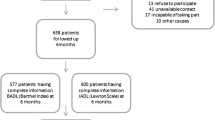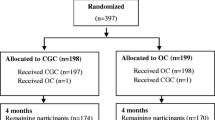Abstract
Summary
Modifiable and non-modifiable predictors of mobility recovery were analyzed on a sample of 774 hip fracture patients according to pre-fracture abilities. Overall predictors were mostly non-modifiable factors related to frailty of patients with the exception of 25-hydroxyvitamin D concentration which significantly affected walking recovery, especially in patients with higher pre-fracture performance.
Introduction
This study aims to investigate mobility changes after hip fracture with the aim of identifying modifiable and non-modifiable predictors of mobility recovery according to different pre-fracture abilities.
Methods
This is a prospective inception cohort study of consecutive older patients, admitted with a fragility hip fracture in three Hospitals of Emilia Romagna (Italy). A sample of 774 patients alive at the sixth month was divided into three groups according to pre-fracture ambulation ability (group 1: mobile outdoors; group 2: mobile indoors; and group 3: mobile with help). The relationship between baseline characteristics of patients and the odds of walking recovery was analyzed using multivariate regression analysis.
Results
Mortality differed significantly among the three groups and was the highest in patients needing help to walk. Among the survivors, only 50.3 % of patients recovered walking ability. In a multivariate analysis, independent risk factors were different among the three groups. In group 1, older age, comorbidities, the use of walking devices before fracture, and low albumin level acted as negative factors while male gender, a pre-fracture high functional status, and higher 25-hydroxyvitamin D levels increased the probability of full recovery. In group 2, only pre-fracture functional status and 25-hydroxyvitamin D concentration were related to the recovery of walking ability. Pre-fracture functional status was also the only significant predictor for patients in group 3.
Conclusions
Several baseline characteristics of patients are related to the likelihood of recovering walking ability after hip fracture. The 25-hydroxyvitamin D level seems to be the only relevant modifiable factor even if the effectiveness of its supplementation has yet to be demonstrated.


Similar content being viewed by others
References
Ferrucci L, Guralnik JM, Simonsick E, Salive ME, Corti C, Langlois J (1996) Progressive versus catastrophic disability: a longitudinal view of the disablement process. J Gerontol A Biol Sci Med Sci 51(3):M123–30
Hung WW, Egol KA, Zuckerman JD, Siu AL (2012) Hip fracture management: tailoring care for the older patient. JAMA 307(20):2185–94
Magaziner J, Hawkes W, Hebel JR, Zimmerman SI, Fox KM, Dolan M, Felsenthal G, Kenzora J (2000) Recovery from hip fracture in eight areas of function. J Gerontol A Biol Sci Med Sci 55(9):M498–507
Lee D, Jo JY, Jung JS, Kim SJ (2014) Prognostic factors predicting early recovery of pre-fracture functional mobility in elderly patients with hip fracture. Ann Rehabil Med 38(6):827–35
Pioli G, Frondini C, Lauretani F, Davoli ML, Pellicciotti F, Martini E, Zagatti A, Giordano A, Pedriali I, Nardelli A, Zurlo A, Ferrari A, Lunardelli ML (2012) Time to surgery and rehabilitation resources affect outcomes in orthogeriatric units. Arch Gerontol Geriatr 55(2):316–22
Salpakoski A, Törmäkangas T, Edgren J, Sihvonen S, Pekkonen M, Heinonen A, Pesola M, Kallinen M, Rantanen T, Sipilä S (2014) Walking recovery after a hip fracture: a prospective follow-up study among community-dwelling over 60-year old men and women. Biomed Res Int 2014:289549. doi:10.1155/2014/289549
Al-Ani AN, Flodin L, Söderqvist A, Ackermann P, Samnegård E, Dalén N, Sääf M, Cederholm T, Hedström M (2010) Does rehabilitation matter in patients with femoral neck fracture and cognitive impairment? A prospective study of 246 patients. Arch Phys Med Rehabil 91(1):51–7. doi:10.1016/j.apmr.2009.09.005
Muir SW, Yohannes AM (2009) The impact of cognitive impairment on rehabilitation outcomes in elderly patients admitted with a femoral neck fracture: a systematic review. J Geriatr Phys Ther 32(1):24–32
Morandi A, Davis D, Fick DM, Turco R, Boustani M, Lucchi E, Guerini F, Morghen S, Torpilliesi T, Gentile S, MacLullich AM, Trabucchi M, Bellelli G (2014) Delirium superimposed on dementia strongly predicts worse outcomes in older rehabilitation inpatients. J Am Med Dir Assoc 15(5):349–54. doi:10.1016/j.jamda.2013.12.084
Mallinson T, Deutsch A, Bateman J, Tseng HY, Manheim L, Almagor O, Heinemann AW (2014) Comparison of discharge functional status after rehabilitation in skilled nursing, home health, and medical rehabilitation settings for patients after hip fracture repair. Arch Phys Med Rehabil 95(2):209–17
Pioli G, Lauretani F, Davoli ML, Martini E, Frondini C, Pellicciotti F, Zagatti A, Giordano A, Pedriali I, Nardelli A, Zurlo A, Ferrari A, Lunardelli ML (2012) Older people with hip fracture and IADL disability require earlier surgery. J Gerontol A Biol Sci Med Sci 67(11):1272–7
Inouye SK, van Dyck CH, Alessi CA, Balkin S, Siegal AP, Horwitz RI (1990) Clarifying confusion: the confusion assessment method. A new method for detection of delirium. Ann Intern Med 113(12):941–8
Pfeiffer EA (1975) Short portable mental status questionnaire for the assessment of organic brain deficit in elderly patients. J Am Geriatr Soc 23:433–441
Charlson ME, Pompei P, Ales KL, MacKenzie CR (1987) A new method of classifying prognostic comorbidity in longitudinal studies: development and validation. J Chronic Dis 40:373–383
Knaus WA, Draper EA, Wagner DP et al (1985) APACHE II: a severity of disease classification system. Crit Care Med 13:818–829
Katz S, Ford AB, Moskowitz RW et al (1963) Studies of illness in the aged: the index of ADL: a standardized measure of biological and psychosocial function. JAMA 185:914–919
Lawton MP, Brody EM (1969) Assessment of older people: self-maintaining and instrumental activities of daily living. Gerontologist 9:179–186
Rosell PA, Parker MJ (2003) Functional outcome after hip fracture. A 1-year prospective outcome study of 275 patients. Injury 34(7):529–32
Vochteloo AJ, Moerman S, Tuinebreijer WE, Maier AB, de Vries MR, Bloem RM, Nelissen RG, Pilot P (2013) More than half of hip fracture patients do not regain mobility in the first postoperative year. Geriatr Gerontol Int 13(2):334–41
Xue QL (2011) The frailty syndrome: definition and natural history. Clin Geriatr Med 27(1):1–15
Dubljanin-Raspopovic E, Markovic-Denic L, Matanovic D et al (2012) Is pre-fracture functional status better than cognitive level in predicting short-term outcome of elderly hip fracture patients? Arch Med Sci 8:115e122
Uriz-Otano F, Uriz-Otano JI, Malafarina V (2014) Factors associated with short-term functional recovery in elderly people with a hip fracture. Influence of cognitive impairment. J Am Med Dir Assoc. doi:10.1016/j.jamda.2014.09.009
Rolland Y, Pillard F, Lauwers-Cances V et al (2004) Rehabilitation outcome of elderly patients with hip fracture and cognitive impairment. Disabil Rehabil 26:425e431, Seitz DP
Gill SS, Gruneir A et al (2014) Effects of dementia on postoperative outcomes of older adults with hip fractures: a population-based study. J Am Med Dir Assoc 15:334e341
Morghen S, Gentile S, Ricci E et al (2011) Rehabilitation of older adults with hip fracture: cognitive function and walking abilities. J Am Geriatr Soc 59:1497e1502
Bellelli G, Mazzola P, Morandi A, Bruni A, Carnevali L, Corsi M, Zatti G, Zambon A, Corrao G, Olofsson B, Gustafson Y, Annoni G (2014) Duration of postoperative delirium is an independent predictor of 6-month mortality in older adults after hip fracture. J Am Geriatr Soc 62(7):1335–40
Giusti A, Barone A, Razzano M, Pizzonia M, Oliveri M, Palummeri E, Pioli G (2006) High prevalence of secondary hyperparathyroidism due to hypovitaminosis D in hospitalized elderly with and without hip fracture. J Endocrinol Invest 29(9):809–13
LeBoff MS, Hawkes WG, Glowacki J, Yu-Yahiro J, Hurwitz S, Magaziner J (2008) Vitamin D-deficiency and post-fracture changes in lower extremity function and falls in women with hip fractures. Osteoporos Int 19(9):1283–90
Bischoff-Ferrari HA, Dietrich T, Orav EJ, Hu FB, Zhang Y, Karlson EW, Dawson-Hughes B (2004) Higher 25-hydroxyvitamin D concentrations are associated with better lower-extremity function in both active and inactive persons aged > or =60 y. Am J Clin Nutr 80(3):752–8
Lauretani F, Frondini C, Davoli ML, Martini E, Pellicciotti F, Zagatti A, Giordano A, Zurlo A, Pioli G (2012) Vitamin D supplementation is required to normalize serum level of 25OH-vitamin D in older adults: an observational study of 974 hip fracture inpatients. J Endocrinol Invest 35(10):921–4. doi:10.3275/8457
Dam TT, von Mühlen D, Barrett-Connor EL (2009) Sex-specific association of serum vitamin D levels with physical function in older adults. Osteoporos Int 20(5):751–60
Ponten JB, Krug E, van Baardewijk LJ, van der Linden EH, Haas R, Krijnen P, Schipper IB (2015) Intensive rehabilitation in selected hip fracture patients may optimize care efficiency: a retrospective comparison study. J Rehabil Med 47(3):278–81
Auais MA, Eilayyan O, Mayo NE (2012) Extended exercise rehabilitation after hip fracture improves patients’ physical function: a systematic review and meta-analysis. Phys Ther 92(11):1437–51. doi:10.2522/ptj.20110274
Author information
Authors and Affiliations
Corresponding author
Ethics declarations
Conflicts of interest
None.
Funding
The study was funded by the Emilia Romagna Region (Region-University Research Program 2007–2009).
Additional information
Authorship
All authors had access to the data and played a role in writing this manuscript.
Rights and permissions
About this article
Cite this article
Pioli, G., Lauretani, F., Pellicciotti, F. et al. Modifiable and non-modifiable risk factors affecting walking recovery after hip fracture. Osteoporos Int 27, 2009–2016 (2016). https://doi.org/10.1007/s00198-016-3485-y
Received:
Accepted:
Published:
Issue Date:
DOI: https://doi.org/10.1007/s00198-016-3485-y




